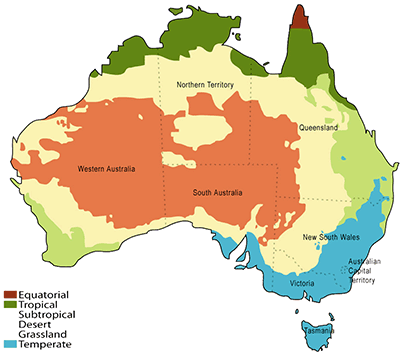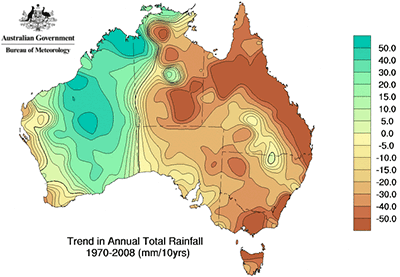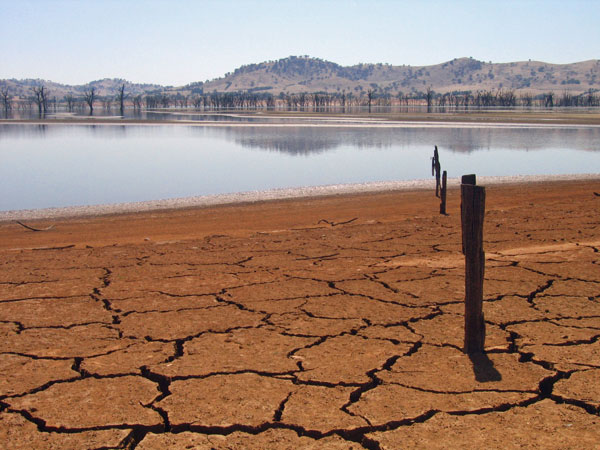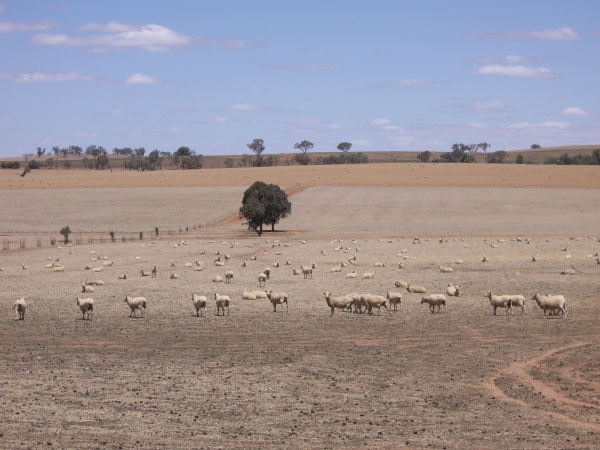When we take a look at the continent of Oceania we see:
- many small islands distributed mainly in the intertropical region,
- two countries which are also islands but much bigger than the others (New Guinea and New-Zealand) and
- a very big island as the size of Europe: Australia.
In Australia, due to its vast size, the climate differs from one part of the country to the other. The northern third of Australia lies in the tropics where the weather is warm or hot the year around. The rest of the country lies south of the tropics and has warm summers and mild or cool winters.
Australia receives most of its moisture as rain. Snow falls only in Tasmania and the Australian Alps. About a third of the country is desert and receives less than 250 millimeters of rain a year. Much of the rest of Australia has less than 500 millimeters of rainfall annually. Rainfall is seasonal almost throughout all of Australia and dry periods are a natural part of life in the country, particularly in the areas away from the coast. Lying directly under the subtropical belt of high pressure, much of Australia experiences low, but highly variable, rainfall, and years with well below normal rain are to be expected.
When do we begin to talk about drought?
Giving a universal definition of drought is not easy because it can affect any place in the world and its features vary from region to region. In the most general sense, drought originates from a deficiency of precipitation over an extended period of time, resulting in a water shortage for some activity, group, or environmental sector. Whatever the definition, it is clear that drought cannot be viewed solely as a physical phenomenon.

Australia Climate zone - Source

Source: Australian Government, Bureau of Meteorology
Four severe droughts
During the last 30 years, Australia underwent 4 important droughts:
- In 1982 Eastern Australia suffered an extensive drought, particularly in the southeast. Extensive areas, including all of Victoria and southern New South Wales have recorded low rainfall for the period of April 1982-February 1983. This drought was also the cause of severe dust storms in north-western Victoria and severe bushfires in the south east.
- A very severe drought occurred in the second half of 1991 in the state of Queensland. About three-quarters of the state recorded very low rainfall from March to November 1991. It was the driest such period on record in parts of the Darling Downs. The northern half of the state of New South Wales was also seriously affected with about half this region affected by an important deficit of precipitation during the same nine months.
- During 2002, Australia experienced its worst drought since reliable records began in 1910. The average Australian rainfall for the spring, summer and autumn 2002 was the lowest ever recorded. The drought was concentrated in eastern Australia especially in the Murray-Darling Basin (the nation’s agricultural heartland). This drought has had a more severe impact than any other drought since at least 1950, because the temperatures in 2002 have also been significantly higher than in other drought years. The higher temperatures caused a marked increase in evaporation rates, which sped up the loss of soil moisture and the drying of vegetation and watercourses.
- Since November 2006, from the late-winter to mid-spring rainfalls had failed in the state of South Australia. Across Victoria and the Murray-Darling Basin the season was the second driest since 1900. New South Wales' rainfall was boosted by above normal precipitation along the north coast of the state; however the state average rainfall for the season is the third driest since 1900. The situation has been worsened by very high temperatures.

Displacement of lake Hume’s shore (New South Wales state) - Source
The common thread between these 4 events is that they occurred at the same time as El Niño. As we know, the term El Niño refers to a sequence of changes in circulations across the Pacific Ocean and Indonesian archipelago when warming is particularly strong (on average every three to eight years). One of the consequences of this phenomenon in Australia is the occurrence of droughts. The physical causes of drought during El Niño events have their origins in the natural fluctuations of the global climate system, which is an extremely complex mix of different subsystems.
However, during the last 50 years the Australian average surface temperature increased by more than 0.7ºC. A one-degree average temperature increase may appear to be a relatively small increase but it can have a major impact on the severity of drought.
Higher temperatures lead to higher evaporation of water from the soil, plants, lakes, and rivers. This places stress on water supplies and has a detrimental impact on vegetation health and agricultural productivity. Under normal conditions evaporation rates in Australia are high, with almost 90% of the precipitation that falls on the country returned through evapotranspiration to the atmosphere. As a result of the higher maximum temperatures, the evaporation rates in 2002 for example were significantly higher. This warming trend cannot be explained by natural climate variability and most of this warming is likely due to the increase in greenhouse gases in the atmosphere.

Riverina Sheep during drought Photograph taken by VirtualSteve
Since 1950, besides the droughts, the trend is towards an increase of the average temperature and a decrease of the rainfall mainly over Southern and Eastern Australia. The situation is critical because the three most populated states are concerned (Victoria, New South Wales and Queensland) and no evidence shows that this trend will change in the near future.
Sources
Australia Burning Up and Drowning at the Same Time -Climaticide Chronicles
Australian Climate - World Book - Encyclopedia and Learning Resources
Climate - Australian Government - Bureau of Meteorology
Climate change hits hard in the Australian outback - CS Monitor
El Niño Drought in Australia 1982-1983 - University of Washington
Rainfall Deficiencies and Drought Information - Australian Government - Bureau of Meteorology
What is Drought? National Drought Mitigation Center - University of Nebraska
This page was written in 2009, as additional information to the poster series "10 years of Imaging the Earth"